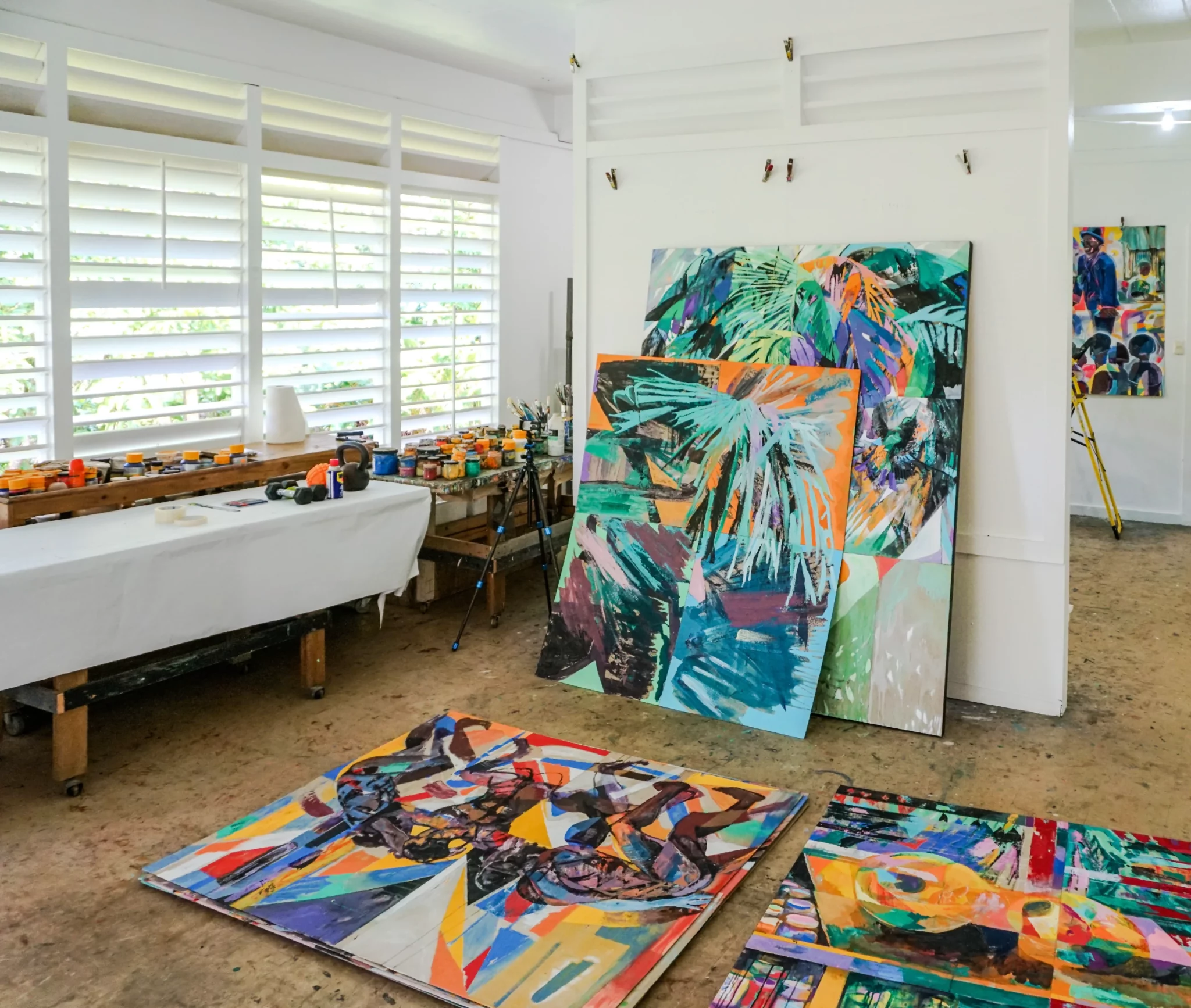
Ahead of Carnival season across the Caribbean and its Diaspora, Che Lovelace welcomed Elephant contributor Amber Smith into his studio to learn more about his practice, inspirations, and passion for Carnival and cultural perseverance.
The drive from our side of the island to the studio was an enticing ride along the ocean full of fish shops and people splashing in the water for fun and relief from the heat. Turning down the road to the former military base where Lovelace’s Studio resides, the beautiful blue sky and lush greenery was a deceptively serene start to a weekend full of pre-carnival fetes, all still in full swing beyond the sunrise. The studio was a cosy space flooded by golden afternoon light, making it easy to understand why he noted needing time in his studio to really sit with and dream about his work, aiding this effort by suspending them on the ceiling at times to view before bed.
The beauty in Lovelaces’ vibrant blend of colourful abstract figurative paintings is that they showcase all corners of Trinidad’s rich and fruitful land, passionate people, and enduring legacy of celebration and freedom. Cycling around the body, landscapes, and interiors. “There’s a diverse cross-section of people and things that attract me and keep my attention here in Trinidad, and I reflect that in my work. Their quirkiness and other idiosyncrasies you cannot figure out always keep me engaged because I want to learn more. Something needs to be eluding me for me to stay engaged with it. That is just like the natural sort of way that I see the world. Also, with Trinidad, you have a powerful sense of identity that aligns with the vegetation and nature, for example, when I paint a bird, coconut palm, plantain, or guava trees that grow wild here. This strong identity aligns with the nature of the place, and I use it in my art to speak about where I am coming from.”
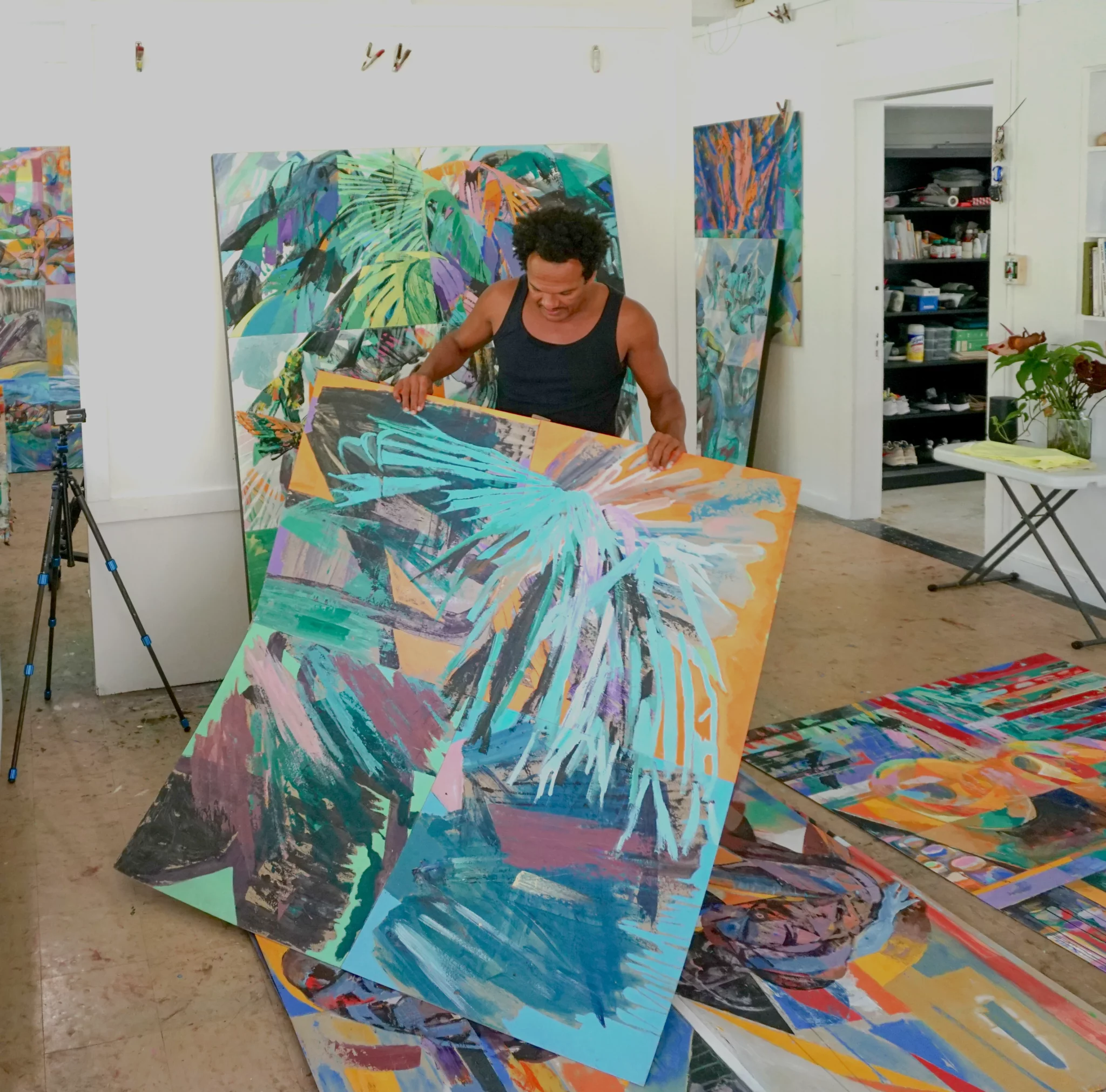
Trinidad also has a rich tradition of painting, very strong post-WWII and the late 40s, and there still is. Lovelace draws much inspiration from this history, the light flowing through his studio, and the exciting colours of his island. “There’s a lot to reflect on, you know, and how that is done is the central question. I have felt in the past that sometimes, the way that the Caribbean has been depicted was done in a very cliche way, and I wanted to stay away from that. So, when I got back into painting Caribbean scenes and cultural things, I wanted to do it differently regarding colours and surfaces beyond just showing Caribbean life. Also, I like to let Trinidad be a place from which you are looking into the world where you can get things to paint and reflect upon but from where we can look at the wider world as well.”
Lovelaces’ work begins as modular style boards developed over time after playful organic experimentation. As the segments evolve from tools to test textures and colours to the foundation of his work, they lend to the formation of the figurative components. “There are times when I look at the works and can picture the scene. After playing around with the components, I put them together, and that is the exciting part for me, feeling that the work can go in any direction”.
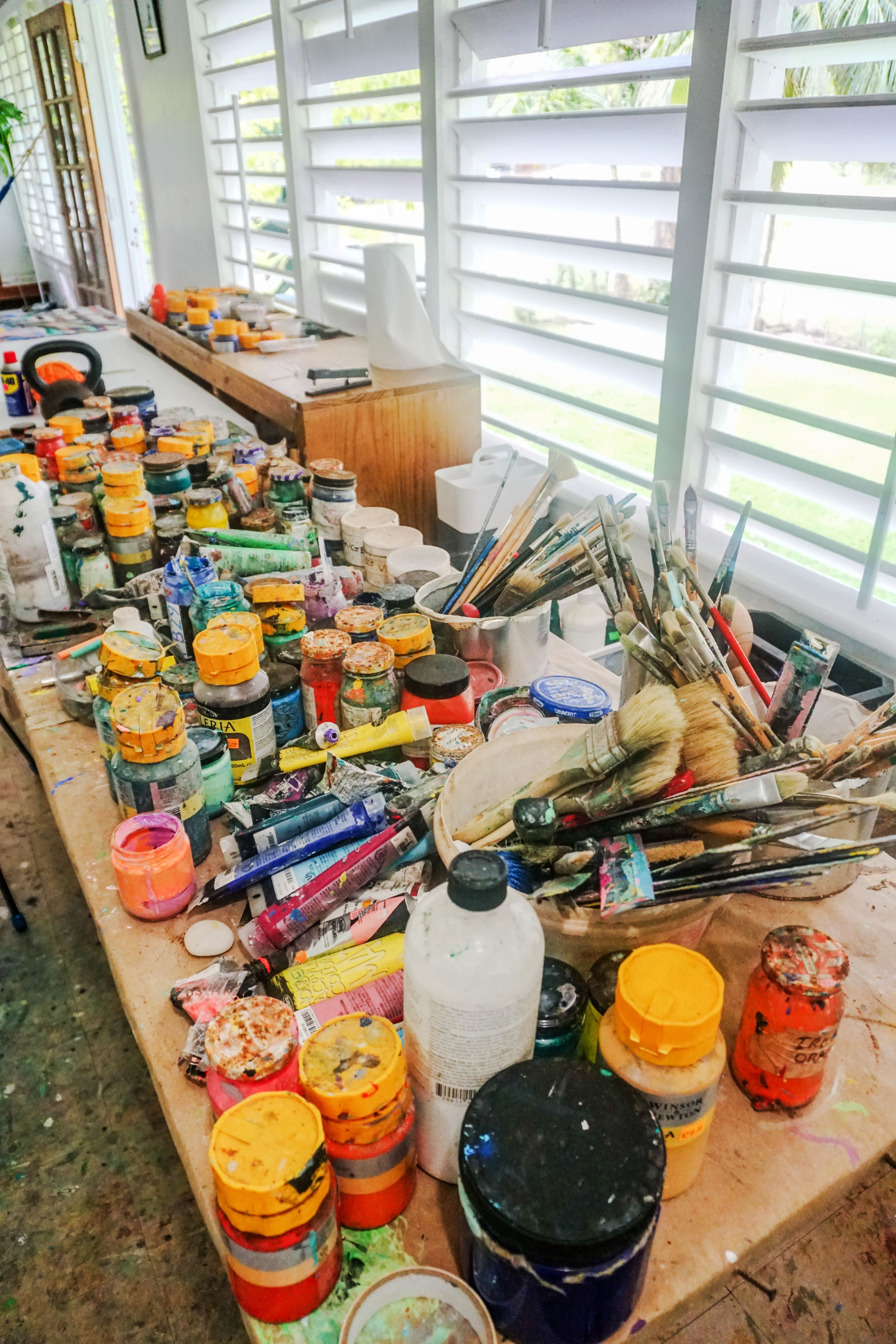

Once the arrangement of the puzzle-like boards is finalized, he ensures the seams remain imperfect and visible, as a nod to the idea of the Caribbean being a large fragment of land with cohesive yet fractured seams. The inclusion of figuration starts when he wants to develop more definitions in the alternating background and foreground layers—choosing from a variety of recurring motifs such as cityscapes, foliage, streets, rivers, celebrations, fruit, and interiors. Leading to “something that has a loose structure and concept, in the beginning, starting to have a human element, and there is a magical moment where you can feel the figures emerging, but at the same time, wanting to make a scene close to the actual place, which is always a challenge with me because I don’t want to get too close to realism, or a realistic space too quickly.”
These scenes frequently include the famous carnival celebrations. Lovelace is an active participant and documentarian with the formation of his J’Ouvert band,” Friends for the Road” and Blue Devil Mas. The Carnival comes to a close in February, but the spirit continuously lingers on the island.
On his connection to the Blue Devil, Lovelace shared, “I always had an attraction to the Blue Devil character; I think it had to do with the way they move. They move very quickly and spontaneously. They are wild characters with particular movements and dances as a group. When I first started with the Blue Devil character, I had to try to understand the group’s dynamic because I was just doing my own thing. While the band allows you the space to be an individual, there is a need to understand the group’s movements. It is truly a creature you become; it is very cool and engrossing in a way because when you are playing that character, it feels quite believable, even for yourself. I have wings, so I would leave the group, run up beside a hill, perch there, and become the creature. He later recounted a story of an early interaction with the Blue Devils. “The parade was coming all the while; the different bands would come in, sometimes with five or six Blue Devils to possibly 20, and they always have musicians playing, Tap, Tap, Tap. All with tin pans and sticks in a similar rhythm, and they came to the side of a hill in view of a little house, and suddenly, stuff just started flying around from the house in the air, including a whole bed and a chair. It was so intense in a poetic way because it had something to do with clearing something out physically and energetically. It was the type of thing that made you question what you know and what is real. And I said, you know, if I could have that intensity playing this character, that would be moving…. that type of intensity”.
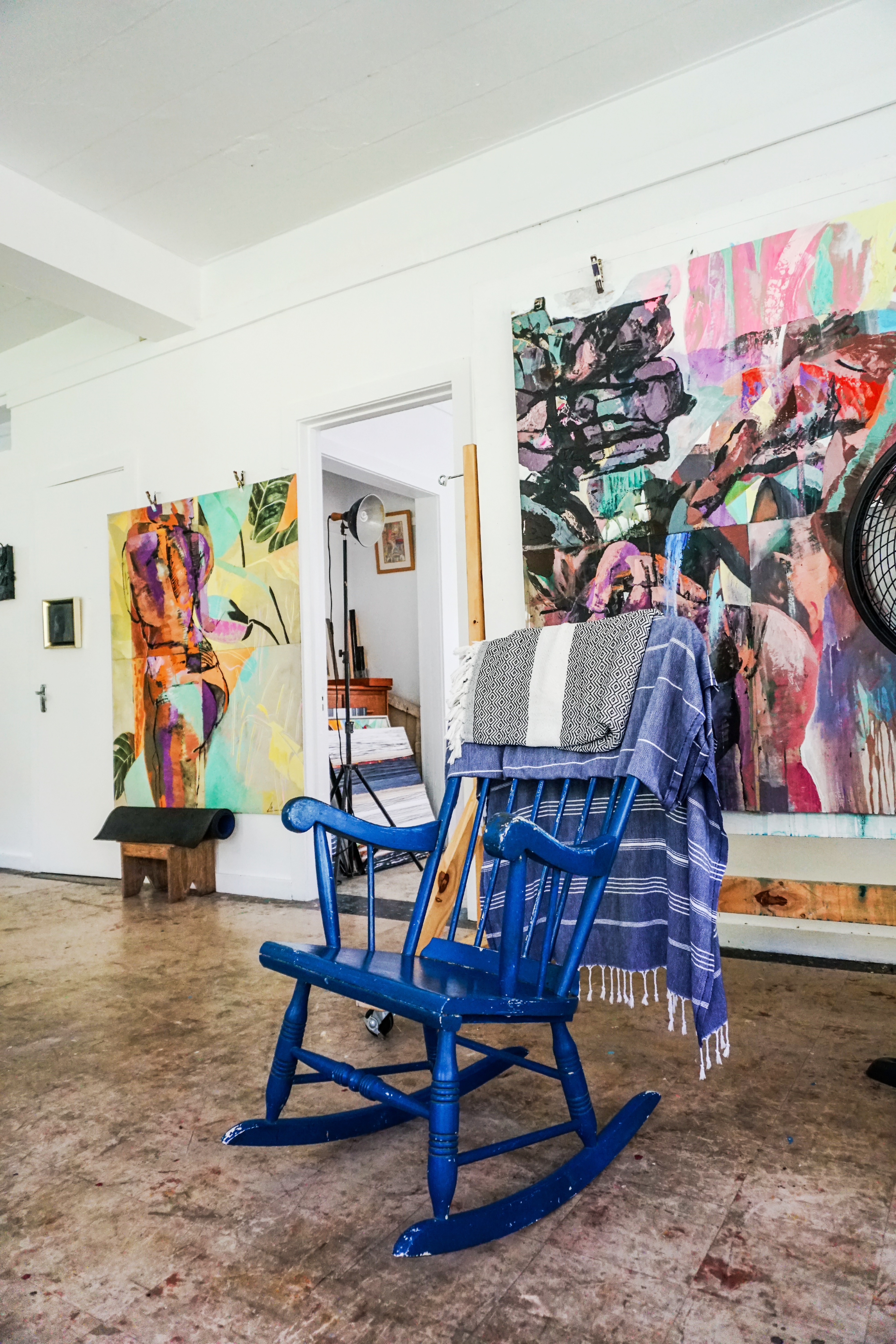
In addition to the Carnival, he also highlights the musicians in the region. “When I depict musicians, it tends to be out of inspiration to feature a particular aspect of the culture, and I just let it sink in naturally and see how it affects the characters I am painting.”
He is also connected to the waves and land as an avid surfer, which he has been as long as he has been a painter. But because water is such a powerful force in his life, creating the translucent flowing rivers and waves in his paintings is a bit daunting.
One consideration Lovelace finds challenging when presenting his catalogue of works that have evolved over the years is having a true dialogue and connection between different periods of his work. “Sometimes creating links is very difficult. The easier thing is always to put work from a particular era or time frame together because there will be cohesiveness to that, but that removes some of the story and depth. Whereas if you take, say, a work from 7 years ago and put it next to what I am doing now, there is a skill to finding that balance”. This balance between the subjects and styles can be seen in his exhibitions, which are currently on view in London and will soon be on view in Texas in March.
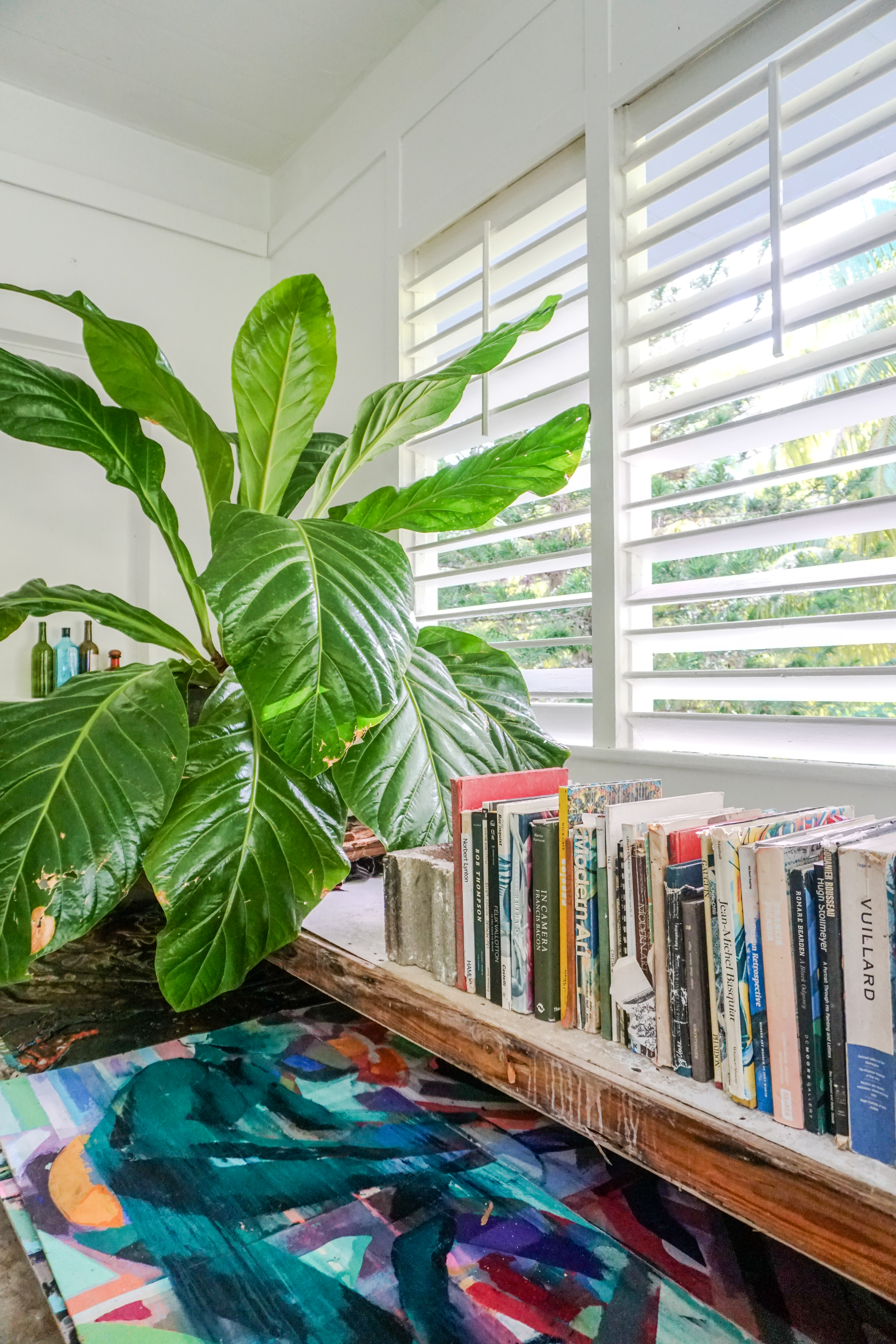
Che Lovelace’s work is included in the recently opened show “Soulscapes” curated by Lisa Anderson, exploring our connection with the world around us, highlighting the power of landscape art, and reflecting on themes of belonging, memory, joy, and transformation at Dulwich Picture Gallery in London till June 2nd, 2024, with limited prints of his work “The Climber” 2022 available for admirers. Additionally, Lovelace work is being shown permanently at St James Church in London to commemorate Quobna Ottobah Cugoano’s baptismal anniversary year. Lovelace’s commission at St. James is the first permanent art commission to commemorate Cugoano’s life anywhere in the world. Lovelace will also be showing in “Surrealism and Us: Caribbean and African Diasporic Artists since 1940,” curated by María Elena Ortiz. Inspired by the history of Surrealism in the Caribbean with connections to notions of the Afrosurreal in the United States. Representing a global perspective, this exhibition is the first intergenerational show dedicated to Caribbean and African diasporic art presented at the Modern in Fort Worth, Texas, opening on March 10th.
Written by Amber Smith





